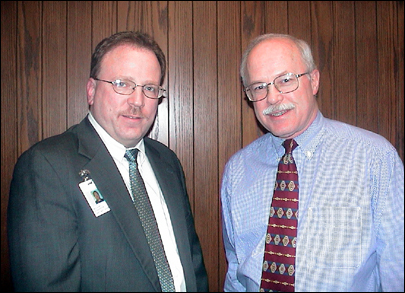Sep 12, 2005At St. Clair Hospital, in Pittsburgh, the medical staff in one of the hospital's surgical units is using dual bar code and RFID readers to track medication administered to patients. Plugged into palm-size Pocket PCs linked to the hospital's computer network via a Wi-Fi connection, the devices save the staff time and help prevent errors.
Manufactured by Socket Communications, the CF RFID Reader-Scan Card Series 6 is the first system of its kind, according to Socket's VP of marketing, Peter Phillips. Although other RFID hardware providers have combined bar code scanners with RFID readers in one device, this is the first time the dual features are available in a CompactFlash card to be inserted in a Pocket PC.
The system is available on a Pocket PC using Windows Mobile software, rather than a larger laptop or desktop computer. Therefore, the process of using both bar code and RFID scanning is more accessible to nursing staff. Until St. Clair began using the Series 6 solution, nurses worked with laptop computers on carts that allowed bar code scanning in patients' rooms. The carts, however, were so unwieldy that the system was rarely used, according to Rich Schaeffer, VP of technology at St. Clair.
"The fact that you can take that device [CF RFID Reader-Scan Card] and plug it into a Pocket PC is a huge adoption [incentive] for nurses," Schaeffer says.
St. Clair is adopting the new Series 6 system as part of the hospital's Five Rights Medication Verification system to ensure medications are not incorrectly administered. In March 2004, St. Clair began implementing Sculptor Developmental Technologies' VeriScan bar code software system, which works in conjunction with Socket's CF Scan Card Series 5 CompactFlash bar code scanner. It added the 13.56 MHz RFID option this month, giving it dual RFID and barcode capacity. The CF RFID Reader-Scan Card uses SocketScan keyboard wedge software that reads RFID or bar-coded data directly into any active Windows program. SocketScan also enables the assignment of a trigger button and a beep tone to signify a successful scan.
The pilot will be held for another week. If it continues to operate without errors, as hospital administrators expect, St. Clair will begin adding enough Pocket PCs with CF RFID Reader-Scan Cards to equip nurses in all 16 units of the 331-bed facility, says Tom Ague, St. Clair COO. That would mean six to eight devices per unit, according to Schaeffer.
Currently, the pilot is taking place in one surgical unit in the hospital. Nurses wear badges with passive ISO 15693 RFID tags, which they scan by waving the Pocket PC within a few inches of the badge before administering medication to any patient. After selecting the name of the patient on the PC's screen, the nurse scans the bar code on the medication she intends to administer and is alerted on the screen as to whether that medication is correct, and what the dosage should be. Finally, before administering the drug, the nurse scans the patient's RFID wristband by bringing the Pocket PC within a few inches to ensure he or she is indeed the individual who should be receiving the medication.
By adding the RFID option, Ague says, the St. Clair staff is able to scan more easily their own badges, as well as the patients' wristbands, without the line of sight necessary for a bar code reader. "As busy as nurses are today, every little step you can save is very important to them, and it drives adoption," Schaeffer says.
The hospital intends to expand the program to check blood transfusions and lab specimens by the end of the year. This would operate similarly to the current pilot, with bar codes used to identify containers of blood and lab specimens, and RFID tags to identify personnel and patients.
The Reader-Scan Card Series 6 reader RFID range is about 3 inches, Phillips says, and is available with a Class 1 laser bar code scanner, which St. Clair is using, or a Class 2 scanner, which has a more powerful laser and, therefore, a longer read range. The CompactFlash reader card will be commercially available Sept. 12, Phillips says, and will cost between $729 for the Class 1 version and $799 for the Class 2.


